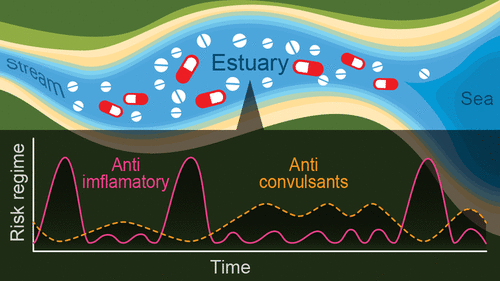当前位置:
X-MOL 学术
›
Environ. Sci. Technol.
›
论文详情
Our official English website, www.x-mol.net, welcomes your feedback! (Note: you will need to create a separate account there.)
Ecological Risk Dynamics of Pharmaceuticals in Micro-Estuary Environments.
Environmental Science & Technology ( IF 11.4 ) Pub Date : 2020-08-15 , DOI: 10.1021/acs.est.0c02434 Tom Topaz 1 , Alistair Boxall 2 , Yair Suari 3 , Roey Egozi 4 , Tal Sade 3 , Benny Chefetz 1
Environmental Science & Technology ( IF 11.4 ) Pub Date : 2020-08-15 , DOI: 10.1021/acs.est.0c02434 Tom Topaz 1 , Alistair Boxall 2 , Yair Suari 3 , Roey Egozi 4 , Tal Sade 3 , Benny Chefetz 1
Affiliation

|
Micro-estuarine ecosystems have a surface area <1 km2 and are abundant in Mediterranean regions. As a result of their small size, these systems are particularly vulnerable to the effects of chemical pollution. Due to the fluctuating flow conditions of base flow dominated by treated wastewater effluents and flood events transporting rural and urban non-point-source pollution, micro-estuaries are under a dynamic risk regime, consequently struggling to provide ecological services. This 2 year study explored the occurrence and risks of pharmaceutical contamination in the Alexander micro-estuary in Israel. Pharmaceuticals were detected in all samples (n = 280) at as high as 18 μg L–1 in flood events and 14 μg L–1 in base flow. The pharmaceutical mixture composition was affected by flow conditions with carbamazepine dominating the base flow and caffeine dominating flood events. The median annual risk quotients for fish, crustaceans, and algae were 19.6, 5.2, and 4.5, respectively, indicating that pharmaceuticals pose a high risk to the ecosystem. Ibuprofen, carbamazepine, and caffeine contributed most to the risk quotients. The current work highlights that micro-estuary ecosystems, like the Alexander estuary, are continuously exposed to pharmaceuticals and most likely to other pollutants, placing these ecologically important systems under an elevated risk in comparison to the more frequently studied large estuarine systems.
中文翻译:

微微观环境下药品的生态风险动态。
微型河口生态系统的表面积<1 km 2,在地中海地区丰富。由于其体积小,这些系统特别容易受到化学污染的影响。由于基流的波动条件主要由处理后的污水和运输农村和城市面源污染的洪水事件主导,因此微型河口处于动态风险机制下,因此难以提供生态服务。这项为期2年的研究探讨了以色列亚历山大微型河口中药物污染的发生和风险。在所有样品(n = 280)中检测到的药物在洪灾事件中的浓度高达18μgL –1,在液体中的含量高达14μgL –1在基本流程中。药物混合物的组成受到流动条件的影响,其中卡马西平占基本流量,咖啡因占主导。鱼,甲壳类和藻类的年风险中位数分别为19.6、5.2和4.5,这表明药物对生态系统构成了高风险。布洛芬,卡马西平和咖啡因对风险商的贡献最大。当前的工作凸显出,像亚历山大河口这样的微型河口生态系统持续暴露于药物中,并且最有可能暴露于其他污染物,与更频繁研究的大型河口系统相比,这些重要的生态系统处于较高的风险之下。
更新日期:2020-09-15
中文翻译:

微微观环境下药品的生态风险动态。
微型河口生态系统的表面积<1 km 2,在地中海地区丰富。由于其体积小,这些系统特别容易受到化学污染的影响。由于基流的波动条件主要由处理后的污水和运输农村和城市面源污染的洪水事件主导,因此微型河口处于动态风险机制下,因此难以提供生态服务。这项为期2年的研究探讨了以色列亚历山大微型河口中药物污染的发生和风险。在所有样品(n = 280)中检测到的药物在洪灾事件中的浓度高达18μgL –1,在液体中的含量高达14μgL –1在基本流程中。药物混合物的组成受到流动条件的影响,其中卡马西平占基本流量,咖啡因占主导。鱼,甲壳类和藻类的年风险中位数分别为19.6、5.2和4.5,这表明药物对生态系统构成了高风险。布洛芬,卡马西平和咖啡因对风险商的贡献最大。当前的工作凸显出,像亚历山大河口这样的微型河口生态系统持续暴露于药物中,并且最有可能暴露于其他污染物,与更频繁研究的大型河口系统相比,这些重要的生态系统处于较高的风险之下。


























 京公网安备 11010802027423号
京公网安备 11010802027423号